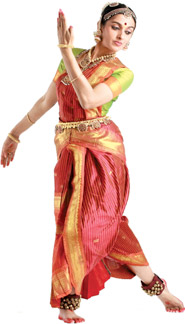Nirtha choreography in Indian classical dances
Subashini PATHMANATHAN
Bharatha Natyam is divided into three main divisions. Nirtha Nirthya
and Natya. Nirtha consists of a variety of steps and sculptural poses.
Meanwhile interpreting the meaning of the song with emotions through
Bhava and Rasas would be considered as the Nirthya concept of dance.
|

Each Indian classical dance has its own unique style and
standard |
Abinaya plays a major role in certain Indian classical dance forms.
Abinaya means the interpretation of songs through hand gestures and
facial expressions. The dancer expresses and expounds the manodharma of
the songs through Bavas and Rasas.
The essence of Abinaya is called Bavas and the substance of Bava is
called Rasas. The concept of Bava can be seen not only in dance but also
one can also feel it in singing in the vocal music. In olden days the
hereditary members of the Isai Vellala families preserved the Bavas and
Rasas in dance and music. Through Abinaya the dancer reaches the hearts
of the audience. In music this is done through Raga or the tone. The
musician reaches the hearts of the people through singing.
The ability in expressing Abinayas (Bava and Rasas) differs from
person to person. The abinayas were referred to by the Sillapathikaram
commentator Adiyarku Nallar as Molliya Moli which means language without
language only through expressions.
Interpreting the theme based dance through different characteristic
roles is regarded as Natya in dance.
The present generation Bharatha Natya dance teachers pay more
attention to training the Nirtha aspect of dance than Nirthya and Natya.
The Nirtha portion is more or less technical and mechanical. It is easy
for a teacher to train the Nirtha aspect of dance rather than Nirthya
and Natya. Nirtha is more or less exercise based. Yet it has its own
grace. Bharatha Natyam all over the world is adopting numerous
mechanical methods and technical methods to learn and teach.
Earlier in Gurukula methods an equal attention was paid by the
teachers to impart Nirtha, Nirthya and Natya together in dance.
Imparting Nirthya
and Natya is time consuming. Therefore the teacher needs to spend
more time with the students. However earlier Bharatha Natyam was more
graceful than the present Bharatha Natyam styles. At present dance
classes are conducted in big groups. Teachers do not pay much attention
to impart the nuances of dance at such classes. The execution of
Nirthiya in dance depends on personal ability and the imaginative
creativity of the artiste. Experience too plays a major role. Sathir
(the earlier form of Bharatha Natyam) danced by Nautch dancers used
various subtle movements in dance. This engaged lip, eye and eye brow
movements.
The Nautch dancers were called Devadasis. Their way of interpretation
of songs was direct but today Bharatha Natyam dancers interpret songs
invariably and indirectly through Sanchari Bava. Sanchari Bava means
that one particular line is invariably interpreted by the dancer through
different ways. The Devadasis never used much Sanchari Bavas.
Each Indian classical dance has its own unique style and standard.
Most of the dances were solo performances but with the passage of time
all the dances were performed in groups. Bharatha Natyam, Mohini Attam,
Kuchupidi, Odissi and Kathakali are still performed as individual
dances.
Many present day Bharatha Natya dancers study Abhinaya from Kuchupidi,
Kathakali and Bhgavatha Mela artistes. During the pre- Indian
independence period all the above dances are still performed by males.
There was evidence that many Devadasis and non Devadasi dancers
learnt Abhinaya nuances and mastered their Abhinaya skill under
Kuchupidi teachers.
It is recorded that the famed Abhinaya Queen Balasaraswathi learnt
Abhinaya under a Kuchupidi teacher. It is said that many devoted
non-traditional and outstanding dancers also learnt Abhinayas under
Kathakali exponents. Even the creative dancer Udaya Shanker learnt the
nuances of Abhinaya under Kathakali exponents. |







